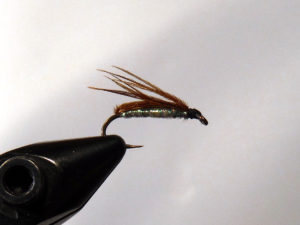Simple Tricks. Flies need not be ornate or tough to tie in order to catch fish. The EZ Nymph and SHWAPF get the job done on the water for trout like this brown, along with bluegills and crappies. Simonson Photo
By Nick Simonson
In all my instructing of fly tying and lure making classes, and when I’m just helping others figure out the basics in an unstructured setting, two nymphs kick off every course and provide a solid base for every fly pattern and jig recipe that might follow. The EZ nymph and the SHWAPF are not only simple in how they tie, but they’re downright effective on every species in the water that targets food items which are about a half-inch brown and buggy. What follows are both patterns to help rekindle a connection at the tying desk this winter, help get a foothold on the fly-crafting ladder, and restock a box with effective flies for bluegills, trout, crappies and other species.
Take It EZ
For something simple that has caught all kinds of trout and is friendly fodder for bluegills on a lazy summer day, the EZ nymph teaches the fundamentals of securing materials to the hook, wrapping them forward, and tying them off. There’s not a lot to it to create a fly that can catch a bunch of fish, it gets its name from its simplicity to create and ease of use.

The EZ nymph comes together quickly and fishes well for both bluegills and trout. It’s a fun and effective first fly that lives up to its name at the vise and on the water. Simonson Photo
MATERIALS
Hook: Nymph Size 12
Thread: Black 6/0
Body/Wing:8 Pheasant Tail (PT) Fibers
Start the EZ Nymph by tying in 8 PT fibers at the bend of the hook with the tips pointing back, so they’re about 2.5-times longer than the hook shank. Advance the thread to just behind the hook eye and then wrap the PT fibers forward until they reach the spot where the thread is hanging, where they can be secured on top of the hook shank with a couple wraps of thread. From there, spread the fibers out over the top half of the hook shank, tie them into position to form that wing and build a small thread head (3). Whip finish and add a drop of cement and the fly is complete.
While PT fibers are the go-to for this nymph, you can use whatever feathery materials you have on hand. Change up the thread color for brighter heads and to add a little attraction to the fly.
SHWAPF til You Dropf
If you’re looking for a fly that totally catches fish, is completely customizable, and best of all is easy to tie, look no further than Al Campbell’s Swept Hackle Wingless All-Purpose Fly – or “SHWAPF” for short. This two-material pattern can be tied with just about any feather or hair for the wing and material for the body, but we’re using PT fibers for this one.

The SHWAPF is easily customized and super simple to tie, making it a very effective first fly for new fly crafters, as it catches fish and allows for flexibility and creativity. Simonson Photo
MATERIALS
Hook: Nymph or Dry Size 10-14
Thread: Black 6/0
Wing/Case: 8 PT Fibers
Body:5 Strands Krystal Flash
Start by tying in eight PT fibers by the butt about one hook eye length behind the hook eye of your hook, the fibers extending beyond the hook should be about twice as long as the hook shank . You can use a nymph or a dry, either is fine and will catch fish – use what you have available.
Next, tie in five strands of krystal flash material over the area where you tied in the PT fibers so they also hang off the back of the hook; advance your thread to just behind the hook eye. Wrap the krystal flash fibers forward forming a slightly football-shaped body that is a bit thicker in the middle and tie the fibers off just behind the hook eye and trim off the excess material.
Fold the PT fibers forward and secure them in place with a couple thread wraps, forming the case of the fly. Then fold the fibers back and secure them with a few more thread wraps, forming the start of a thread head, making sure the fibers are distributed evenly around the top half of the fly. From there, build up the thread head, whip finish and add a tiny drop of head cement for posterity.
A single pheasant tail feather can tie up dozens of these flies and they’re cheap and easy to create – you could do 20 in an hour once you get the patterns down. Substitute peacock herl, yarn or dubbing for the krystal flash if you like for a well-rounded selection. Switch the black thread to bright orange or red for some added attraction as well. Totally customizable, fun and easy to tie – that’s how Al intended it!
These two simple nymphs will get tying efforts for the season, or a lifetime, set off on the right foot. Give them both a try and stock up on some simple, effective flies for the fly fishing season to come.
Credit: Source link































